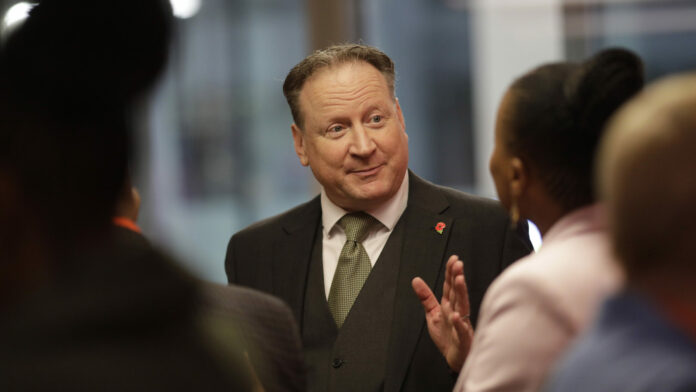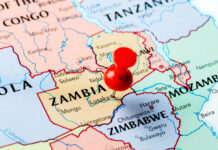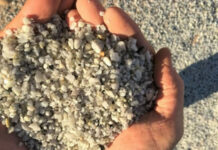
ONE thing resource miners have in spades is optimism. Take South Africa’s latest digger, Neo Energy Metals, which is hoping to build a uranium mine in the Northern Cape. Dubbed yellowcake, the mineral has been out of vogue for more than a decade. But prices have been heading north for the past three years, and in October they hit levels last seen in 2011.
According to the World Nuclear Association, global uranium demand is forecast to reach 83,840 tons in 2030, from 65,650t now, while supply falls 50%. A doubling in the development pipeline is needed to avoid a major supply deficit, the association says.
Yawning supply deficit forecasts are common for energy-transition minerals such as copper. What’s different about uranium is that it is troublesome to license, and nuclear power remains controversial despite its ability to provide baseload power with zero carbon emissions. “We’re very happy with where the market is sitting,” said Sean Heathcote, CEO of Neo Energy. “It’s a perfect time for us.”
Heathcote, a metallurgist who once worked at Anglo American, listed Neo Energy on the London Stock Exchange (LSE) on November 9. The company raised £4.9m but its shares sank back after debut. Unlike Sydney and Toronto, London doesn’t have a uranium exploration play — UK investors don’t generally buy a ‘blue sky’ investment story with quite the same appetite that the Canadian venture capital market does.
Despite this, Heathcote thinks investors will take to the fact that the firm’s prospect — Henkries, near the Orange River about 80km north of Springbok — was previously explored by Anglo American and is therefore derisked. It also has infrastructure, on-site or nearby. “Anglo dug about 211 test pits and ran pilot testing in 1977 when the rand was equivalent to one dollar,” said Heathcote.
An economic feasibility study will reveal more but Heathcote thinks Henkries can be compared to the Tiris project in Mauritania, where Aura Energy is planning capital expenditure of $80m.
New blood & familiar faces
Generally speaking, uranium in South Africa has been a byproduct of gold mining, and hasn’t been produced in meaningful quantities for years. Sibanye-Stillwater thought about converting its Beatrix gold mine into a uranium project, and has bucketfuls of the stuff in tailings west of Johannesburg. CEO Neal Froneman stepped back from both projects, however. “It is not a part of the energy market that will blossom to the extent of other minerals,” he said in June.
Nonetheless, Neo Energy is interesting because it’s another example of the new breed of exploration companies operating in South Africa. The modus operandi is not to risk time and money on greenfields exploration, but to reopen previously explored properties. They then update the resource and take the listing to London, which is more liquid than Joburg. These projects also seem to be almost exclusively run by industry veterans.
Not many miners have made it to the pages of GQ but Van der Burgh is one
UK-listed Rainbow Rare Earths bought gypsum tailings from nearby phosphate mining in the Northern Cape hoping it could attract investors for its plan to extract neodymium and praseodymium. The minerals — which, incidentally, are not especially rare geologically — are used to make permanent magnets in turbines and motors in the renewable energy industry.
George Bennett, who helped found Shanta Gold and sold his MDM Engineering for $120m, is CEO but the company is chaired by Adonis Pouroulis from the Greek-Cypriot clan that has stood behind an array of mining ventures including Keaton Energy, Petra Diamonds and Eland Platinum.
Neo Energy has been brought to the market by Jason Brewer, a former Rothschild & Sons banker who is CEO of London-listed Marula Mining. Marula, which has a secondary JSE listing, is exploring for tantalum and lithium — again in the Northern Cape — and has local investment house Q Global Commodities as a shareholder following a £3.75m investment in January.
Q Global Commodities is owned by glitzy mining entrepreneur Quinton “QvdB” van der Burgh, who claims to have developed 47 mining projects over a 19-year career. Not many miners have made it to the pages of GQ but Van der Burgh is one, describing to the magazine how he graduated from a car phone business in the UK to an empire in South Africa that invests in media as well as mines. It was Van der Burgh who sought to buy coal export entitlement through Richards Bay from the Gupta-owned Optimum Coal Mines.
What does Heathcote make of QvdB? “Well, he’s colourful like all entrepreneurs. He’s a billionaire and very philanthropic in approach and committed into investing into South Africa … as far as I’m aware,” he says.
One market source said the surge in mineral exploration in the Northern Cape is a mixed blessing. It’s promising that South Africa can attract investment into a badly faltering mining sector, the source said, but there might be insalubrious reasons for it. “It could set South Africa’s junior mining sector back 10 years. There are lots of blatant lies and misrepresentations being swallowed by what I thought were sophisticated investors,” the source says. “It will likely end in tears.”
There’s nothing to suggest Neo Energy or Rainbow Rare Earths falls into this category; in fact, shares in Rainbow are 60% higher on the LSE year to date and recently attracted $50m in project equity from TechMet, an investment firm run by Menell-family scion Brian — another old hand — who has secured the backing of the US government’s International Development Finance Corporation.
In any event, local investors may get a chance to judge for themselves at close quarters; Heathcote said a secondary listing on the JSE is “being seriously looked at” for his not-so-neo company.











